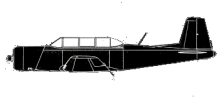
ASN Wikibase Occurrence # 224141
This information is added by users of ASN. Neither ASN nor the Flight Safety Foundation are responsible for the completeness or correctness of this information.
If you feel this information is incomplete or incorrect, you can submit corrected information.
| Date: | Friday 19 April 2019 |
| Time: | 12:40 LT |
| Type: |  Nanchang CJ-6 |
| Owner/operator: | Private |
| Registration: | N621JM |
| MSN: | 4632023 |
| Year of manufacture: | 1989 |
| Total airframe hrs: | 2760 hours |
| Engine model: | Huosai 6JIA |
| Fatalities: | Fatalities: 0 / Occupants: 2 |
| Aircraft damage: | Substantial |
| Category: | Accident |
| Location: | Nevada County Airport (KGOO), Grass Valley, CA -
 United States of America United States of America
|
| Phase: | Landing |
| Nature: | Private |
| Departure airport: | Auburn Municipal Airport, CA (AUN/KAUN) |
| Grass Valley-Nevada County Air Park, CA (KGOO) | |
| Investigating agency: | NTSB |
| Confidence Rating: |
During the landing roll, the pilot applied left rudder and lightly depressed the brake handle to exit the runway. About 30° into the left turn, the brakes failed, and the airplane exited the asphalt taxiway surface. Due to obstructions ahead and the downsloping terrain, the pilot applied right rudder and engine power to realign the airplane with the runway. Shortly thereafter, the airplane overran the departure end of the runway and traveled downslope while airborne. The airplane then touched down and impacted a dirt berm before it collided with a fence, nosed over, and came to rest inverted, sustaining substantial damage to the fuselage and both wings. Examination of the airplane revealed that the brake control cable was fractured near the cable thimble and was separated from the brake control handle. The fracture surfaces of the separated cable were consistent with a fatigue fracture. Six of the seven strands of wires exhibited relatively flat fracture surfaces normally oriented to the wire axis, consistent with a progressive fracture mechanism, such as a fatigue fracture. Only one strand and a few of the remaining individual wires showed evidence of minor elongation at the fracture location. It is likely that the cable completely failed during the landing roll when the pilot depressed the brake handle.
Probable Cause: A loss of brake control due to fatigue fracture of the brake control cable, which resulted in the separation of the cable from the brake handle.
Accident investigation:
 |
|
Sources:
NTSB WPR19LA117
FAA register: https://registry.faa.gov/aircraftinquiry/NNum_Results.aspx?NNumbertxt=621JM
Location
Media:
USA, Nevada County airport - A Nanchang CJ-6 plane with a faulty braking system sent an airplane and its two occupants over the end of the runway at the Nevada County Airport Friday afternoon.
— PLANES OF LEGEND (@PlanesOfLegend) 20 avril 2019
ASN: https://t.co/yUd9iviiGt
Press: https://t.co/CktfkHUzP0 pic.twitter.com/343y2Kooyi
Revision history:
| Date/time | Contributor | Updates |
|---|---|---|
| 19-Apr-2019 22:43 | Captain Adam | Added |
| 20-Apr-2019 01:25 | Geno | Updated [Time, Registration, Cn, Operator, Location, Departure airport, Destination airport, Source, Narrative] |
| 20-Apr-2019 13:05 | Iceman 29 | Updated [Source, Embed code] |
| 02-Jul-2022 09:14 | ASN Update Bot | Updated [Time, Other fatalities, Nature, Departure airport, Source, Embed code, Narrative, Category, Accident report] |
Corrections or additions? ... Edit this accident description
The Aviation Safety Network is an exclusive service provided by:


 ©2024 Flight Safety Foundation
©2024 Flight Safety Foundation